- Afrikaans
- Albanian
- Amharic
- Arabic
- Armenian
- Azerbaijani
- Basque
- Belarusian
- Bengali
- Bosnian
- Bulgarian
- Catalan
- Cebuano
- chinese_simplified
- chinese_traditional
- Corsican
- Croatian
- Czech
- Danish
- Dutch
- English
- Esperanto
- Estonian
- Finnish
- French
- Frisian
- Galician
- Georgian
- German
- Greek
- Gujarati
- haitian_creole
- hausa
- hawaiian
- Hebrew
- Hindi
- Miao
- Hungarian
- Icelandic
- igbo
- Indonesian
- irish
- Italian
- Japanese
- Javanese
- Kannada
- kazakh
- Khmer
- Rwandese
- Korean
- Kurdish
- Kyrgyz
- Lao
- Latin
- Latvian
- Lithuanian
- Luxembourgish
- Macedonian
- Malgashi
- Malay
- Malayalam
- Maltese
- Maori
- Marathi
- Mongolian
- Myanmar
- Nepali
- Norwegian
- Norwegian
- Occitan
- Pashto
- Persian
- Polish
- Portuguese
- Punjabi
- Romanian
- Russian
- Samoan
- scottish-gaelic
- Serbian
- Sesotho
- Shona
- Sindhi
- Sinhala
- Slovak
- Slovenian
- Somali
- Spanish
- Sundanese
- Swahili
- Swedish
- Tagalog
- Tajik
- Tamil
- Tatar
- Telugu
- Thai
- Turkish
- Turkmen
- Ukrainian
- Urdu
- Uighur
- Uzbek
- Vietnamese
- Welsh
- Bantu
- Yiddish
- Yoruba
- Zulu
Innovative Solutions for Eco-Friendly Tissue Packaging in Modern Retail
The Significance of Tissue Packaging in Modern Industries
In today's fast-paced world, the need for efficient and innovative packaging solutions is greater than ever. Among the various packaging methods, tissue packaging stands out for its versatility, sustainability, and aesthetic appeal. This article explores the significance of tissue packaging across different industries, its environmental benefits, and future trends.
What is Tissue Packaging?
Tissue packaging refers to the use of lightweight, thin paper products made from recycled paper or wood pulp, often used to wrap, cushion, and protect various items. It ranges from basic tissue paper used in gift wrapping to high-quality, decorative papers used in luxury packaging. This form of packaging caters to numerous sectors, including food, retail, cosmetics, and e-commerce, providing both functionality and visual appeal.
Applications in Various Industries
1. Food Industry Tissue packaging plays a crucial role in the food industry. It is commonly used to wrap sandwiches, pastries, and other perishable items, providing a barrier against moisture while allowing the food to breathe. This is essential for maintaining freshness and quality. Additionally, tissue packaging can be customized to promote branding, with printed logos and vibrant colors enhancing the customer experience.
2. Retail and Gift Packaging In the retail sector, tissue paper is often used as a filler in shopping bags or as a wrapping material for gifts. Its lightweight nature and ability to add a touch of elegance make it a popular choice among retailers. Custom-designed tissue paper can elevate products and create a lasting impression on consumers, making it a valuable marketing tool.
3. Cosmetics Industry The cosmetics sector employs tissue packaging to offer a luxurious unboxing experience. Brands utilize premium tissue paper to wrap products, ensuring they arrive at their destination securely while enhancing the presentation. The tactile quality of tissue adds an element of sophistication that customers appreciate, fostering brand loyalty.
4. E-commerce With the rise of online shopping, effective packaging has become paramount. Tissue packaging is often used to fill voids in boxes or to wrap fragile items, preventing damage during transit. Its lightweight nature reduces shipping costs, making it an economical choice for e-commerce businesses.
Environmental Benefits
tissue packaging

One of the standout features of tissue packaging is its environmental friendliness. Many tissue papers are made from recycled materials, contributing to waste reduction and promoting sustainability. Additionally, tissue paper is biodegradable and compostable, making it an eco-conscious option compared to plastic packaging. As consumers become increasingly environmentally aware, the demand for sustainable packaging solutions like tissue packaging is expected to grow.
Companies are actively embracing sustainable practices by sourcing materials responsibly and employing eco-friendly production processes. By choosing tissue packaging, businesses not only meet regulatory requirements but also appeal to consumers who prioritize environmentally friendly products.
Future Trends
The future of tissue packaging looks promising, with several trends emerging in the industry
1. Customization and Personalization As consumer behavior shifts towards personalized experiences, the demand for customized tissue packaging is expected to rise. Brands will increasingly adopt unique designs, colors, and patterns that cater specifically to their target audience, creating a more memorable customer experience.
2. Innovative Designs To stand out in a crowded marketplace, businesses will invest in innovative designs that enhance the aesthetic appeal of tissue packaging. This includes the use of eco-friendly inks, embossed patterns, and textures that create a sensory experience.
3. Integration with Technology The integration of technology into packaging is another trend to watch. Augmented reality (AR) features could be added to tissue packaging, allowing consumers to interact with brands in new ways, bringing products to life through digital storytelling.
4. Sustainability Initiatives The emphasis on sustainable practices will continue to grow. Companies will seek certifications and labels that showcase their commitment to environmental responsibility, influencing purchasing decisions.
Conclusion
Tissue packaging is more than just a protective cover; it is a strategic tool that impacts brand perception, consumer experience, and environmental sustainability. As industries evolve and adapt to changing market demands, tissue packaging will play a crucial role in shaping the future of packaging solutions. By embracing innovation and sustainability, businesses can capitalize on the unique advantages of tissue packaging, ensuring they remain competitive in a dynamic marketplace.













